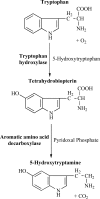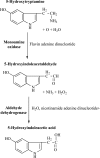Selective serotonin reuptake inhibitors: a review of its effects on intraocular pressure
- PMID: 19587851
- PMCID: PMC2701282
- DOI: 10.2174/157015908787386104
Selective serotonin reuptake inhibitors: a review of its effects on intraocular pressure
Abstract
The increase in serotonin (5-HT) neurotransmission is considered to be one of the most efficacious medical approach to depression and its related disorders. The selective serotonin reuptake inhibitors (SSRIs) represent the most widely antidepressive drugs utilized in the medical treatment of depressed patients. Currently available SSRIs include fluoxetine, sertraline, paroxetine, fluvoxamine, citalopram and escitalopram. The primary SSRIs pharmacological action's mechanism consists in the presynaptic inhibition on the serotonin reuptake, with an increased availability of this amine into the synaptic cleft. Serotonin produces its effects as a consequence of interactions with appropriate receptors. Seven distinct families of 5-HT receptors have been identified (5-HT(1) to 5-HT(7)), and subpopulations have been described for several of these. The interaction between serotonin and post-synaptic receptors mediates a wide range of functions. The SSRIs have a very favorable safety profile, although clinical signs of several unexpected pathologic events are often misdiagnosed, in particular, those regarding the eye. In all cases reported in the literature the angle-closure glaucoma represents the most important SSRIs-related ocular adverse event. Thus, it is not quite hazardous to hypothesize that also the other reported and unspecified visual disturbances could be attributed - at least in some cases - to IOP modifications. The knowledge of SSRIs individual tolerability, angle-closure predisposition and critical IOP could be important goals able to avoid further and more dangerous ocular side effects.
Keywords: Fluoxetine; citalopram; escitalopram; fluvoxamine; intraocular pressure; paroxetine; sertraline; side effects..
Figures




Similar articles
-
Paroxetine : a review of its pharmacology and therapeutic potential in the management of panic disorder.CNS Drugs. 1997 Aug;8(2):163-88. doi: 10.2165/00023210-199708020-00010. CNS Drugs. 1997. PMID: 23338224
-
Pharmacokinetic-pharmacodynamic relationship of the selective serotonin reuptake inhibitors.Clin Pharmacokinet. 1996 Dec;31(6):444-69. doi: 10.2165/00003088-199631060-00004. Clin Pharmacokinet. 1996. PMID: 8968657 Review.
-
Clinical pharmacokinetics of selective serotonin reuptake inhibitors.Clin Pharmacokinet. 1993 Mar;24(3):203-20. doi: 10.2165/00003088-199324030-00003. Clin Pharmacokinet. 1993. PMID: 8384945 Review.
-
Clinically relevant pharmacology of selective serotonin reuptake inhibitors. An overview with emphasis on pharmacokinetics and effects on oxidative drug metabolism.Clin Pharmacokinet. 1997;32 Suppl 1:1-21. doi: 10.2165/00003088-199700321-00003. Clin Pharmacokinet. 1997. PMID: 9068931 Review.
-
Systematic review and guide to selection of selective serotonin reuptake inhibitors.Drugs. 1999 Apr;57(4):507-33. doi: 10.2165/00003495-199957040-00005. Drugs. 1999. PMID: 10235690
Cited by
-
Long-Term Use of Selective Serotonin Reuptake Inhibitors and Risk of Glaucoma in Depression Patients.Medicine (Baltimore). 2015 Nov;94(45):e2041. doi: 10.1097/MD.0000000000002041. Medicine (Baltimore). 2015. PMID: 26559311 Free PMC article.
-
Pharmacological profile of ALKS 7119, an investigational compound evaluated for the treatment of neuropsychiatric disorders, in healthy volunteers.Br J Clin Pharmacol. 2022 Jun;88(6):2909-2925. doi: 10.1111/bcp.15229. Epub 2022 Jan 31. Br J Clin Pharmacol. 2022. PMID: 35014069 Free PMC article.
-
5-HT1A Receptor Agonist Promotes Retinal Ganglion Cell Function by Inhibiting OFF-Type Presynaptic Glutamatergic Activity in a Chronic Glaucoma Model.Front Cell Neurosci. 2019 May 3;13:167. doi: 10.3389/fncel.2019.00167. eCollection 2019. Front Cell Neurosci. 2019. PMID: 31130845 Free PMC article.
-
Management of preoperative hypertension and anxiety based on early monitoring of pulse rate before cataract surgery.Jpn J Ophthalmol. 2024 Nov;68(6):669-675. doi: 10.1007/s10384-024-01124-9. Epub 2024 Sep 28. Jpn J Ophthalmol. 2024. PMID: 39340728 Free PMC article.
-
Stabilization of tryptophan hydroxylase 2 by l-phenylalanine-induced dimerization.FEBS Open Bio. 2016 Aug 22;6(10):987-999. doi: 10.1002/2211-5463.12100. eCollection 2016 Oct. FEBS Open Bio. 2016. PMID: 27761358 Free PMC article.
References
-
- Abdel Latif AA. Cross talk between cyclic AMP and the polyphosphoinositide signaling cascade in iris sphincter and other nonvascular smooth muscle. Proc. Soc. Exp. Biol. Med. 1996;211:163–177. - PubMed
-
- Abe M, Itoh MT, Miyata M, Ishikawa S, Sumi Y. Detection of melatonin, its precursors and related enzyme activities in rabbit lens. Exp. Eye Res. 1999;68:255–262. - PubMed
-
- Adham N, Zgombick J, Bard JA, Branchek TA. Functional characterization of the recombinant human 5-hydroxytryptamine7(a) receptor isoform coupled to adenylate cyclase stimulation. J. Pharmacol. Exp. Ther. 1998;287:508–514. - PubMed
-
- Ahmad S. Fluoxetine and glaucoma. Ann. Pharmacother. (DICP) 1991;25:436. - PubMed
-
- Akhtar RA. Effects of norepinephrine and 5-hydroxytryptamine on phosphoinositide-PO4 turnover in rabbit cornea. Exp. Eye Res. 1987;44:849–862. - PubMed
LinkOut - more resources
Full Text Sources
